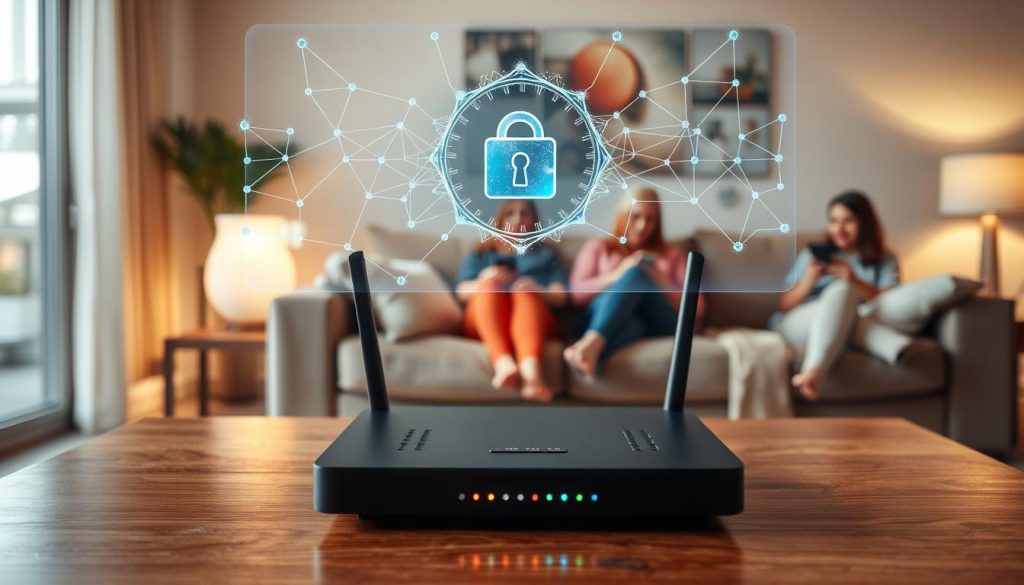Technology keeps getting better, but it also brings new challenges to keeping our data safe. Your home’s privacy is at risk because current encryption methods might not work against quantum attacks. Protecting your personal data is now more important than ever.
Quantum computing is changing the game, bringing both chances and dangers. To keep your home safe, you need to use quantum-resistant cryptography. This is where post-quantum encryption comes in, making sure your data stays safe in the future.
Key Takeaways
- Quantum computing poses a significant threat to current encryption methods.
- Post-quantum encryption is crucial for protecting home privacy.
- Adopting quantum-resistant cryptography is essential for security.
- Your personal data is at risk if current encryption methods are compromised.
- Future-proofing your home privacy requires post-quantum encryption.
Understanding Post-Quantum Encryption
Post-quantum encryption is crucial today, not just for the future. It’s needed to protect our digital communications from quantum threats. As we face a world where quantum computers are becoming more powerful, securing our data is key.
What is Post-Quantum Encryption?
Post-quantum encryption, or quantum-resistant cryptography, is about algorithms that keep data safe from quantum computers. These algorithms are vital. They make sure our encrypted data stays safe, even when quantum computers get stronger.
Creating these encryption techniques is essential. Quantum computers could break many encryption algorithms we use today. This could risk our online transactions and communications.
Importance of Post-Quantum Security
Post-quantum security is very important. As quantum computers get better, they threaten our current encryption systems. Switching to post-quantum encryption helps protect our digital security for the future.
It’s not just about fighting quantum computers. It’s also about keeping our digital world trustworthy. Everyone needs to think about how quantum computing affects their cybersecurity.
Key Differences from Current Encryption Methods
Post-quantum encryption is different from what we use now. Traditional encryption uses hard math problems for security. But post-quantum encryption uses other problems that are harder for quantum computers to solve.
- Post-quantum encryption algorithms are made to resist quantum attacks.
- They use new techniques like lattice-based cryptography and hash-based signatures.
- These algorithms are being tested to ensure they work against both old and new computers.
Knowing these differences helps us see why we need to move to post-quantum encryption. It’s about staying safe from the threats of quantum computing.
Why Home Privacy Matters Today
Smart homes and connected devices are everywhere now. This means protecting your personal space is more important than ever. Adding more tech to your life makes your home smarter but also opens it up to cyber threats.
The digital world is getting more complex. This means the risks to your home privacy are growing. Cybersecurity is now a big deal for homeowners, not just businesses.
Rising Cyber Threats
Cyber threats are getting more common and clever. You face dangers like malware, phishing, and attacks on smart devices. It’s key for homeowners to know these risks and act to protect their digital world.
Data Breaches and Its Impact
Data breaches are happening a lot, and they can really hurt. If your personal info gets stolen, you could face identity theft and financial loss. The effects of a breach can last a long time, affecting your safety and privacy.
It’s important to understand how data breaches can harm you. It’s not just about losing money right away. It can also hurt your credit score and make it hard to get loans or credit. It can even damage your personal relationships.
Importance of Personal Data Protection
Keeping your personal data safe is crucial today. This means being careful about what you share online, using strong passwords, and keeping your software updated. Also, be wary of emails and links from people you don’t know.
Data protection is about more than just avoiding threats. It’s about keeping your digital identity safe. By being proactive about your cybersecurity, you can lower the risk of cybercrime.
In short, home privacy is more critical than ever. This is due to the rise in cyber threats, the impact of data breaches, and the need to protect your personal data. By staying informed and taking action, you can keep your home and privacy safe in the digital age.
How Quantum Computing Threatens Encryption
Quantum computing is a new threat to our digital security. It could break the encryption we use every day. This is a big worry as we rely more on digital tech.
Overview of Quantum Computing
Quantum computing uses quantum mechanics to do calculations faster than regular computers. This is a big deal for many fields, including cryptography.
Quantum Algorithms vs. Traditional Encryption
Quantum algorithms, like Shor’s algorithm, can break some encryption. Our current encryption is based on hard math problems. Quantum computers can solve these problems quickly.
The table below shows how quantum algorithms compare to traditional encryption:
| Encryption Method | Classical Computer Vulnerability | Quantum Computer Vulnerability |
|---|---|---|
| RSA | Low | High |
| AES | Medium | Medium to High (dependent on key size) |
| ECC | Low to Medium | High |
Potential Risks for Home Users
Home users face many risks from quantum computing. More of our personal data is online, making it easier for hackers. It’s crucial for us to protect our digital privacy.
The risks include:
- Unauthorized access to personal data
- Compromise of secure online transactions
- Increased vulnerability to cyber-attacks
Knowing these risks is the first step to protecting ourselves. As quantum computing grows, so must our security measures.
The Basics of Conventional Encryption
Conventional encryption is key to keeping your digital info safe. It’s the foundation of online security, blocking unauthorized access to your data.
AES and RSA Encryption Explained
Two main encryption algorithms are used: AES and RSA. AES is a block cipher for encrypting and decrypting data. It ensures only those with the right key can access it. RSA is for secure data transfer and digital signatures, using asymmetric keys.
AES is popular for its speed and security. It works well for many uses because of its fixed block and key sizes. RSA is often used for internet data transfers, like in SSL/TLS.
How Conventional Encryption Works
Encryption turns plain text into unreadable code. This makes data safe even if it’s caught in transit. The trick is in the algorithms, which rely on hard math problems.
RSA’s strength comes from its math problem, factoring large numbers. AES’s security is in its big keys, making it hard to crack by brute force.

Limitations of Current Encryption Methods
Even with its benefits, conventional encryption has its downsides. Quantum computers could solve these math problems faster, breaking current encryption.
| Encryption Method | Key Feature | Vulnerability to Quantum Computing |
|---|---|---|
| AES | Symmetric-key block cipher | Resistant with large key sizes (e.g., AES-256) |
| RSA | Asymmetric-key algorithm | Vulnerable due to factorization vulnerability |
Knowing these weaknesses is important. It helps us move to new encryption that’s safe from quantum computers.
Transitioning to Post-Quantum Encryption
The world is on the edge of a quantum computing revolution. This makes it urgent to switch to post-quantum encryption. Both businesses and individuals need to plan and act together for this change.
Challenges in Implementation
Switching to post-quantum encryption faces many hurdles. One big issue is making sure new encryption works with old systems. Many systems today use old encryption that quantum computers can break. Upgrading these systems will need big changes to both hardware and software.
Also, the new encryption is more complex and uses more computer power. This can slow down apps and services.
Cost and Accessibility Considerations
The cost of moving to post-quantum encryption is a big worry. Companies will have to spend on new tech that can handle the complex new encryption. This cost includes buying new stuff and keeping it updated over time.
Not everyone can afford or know how to use the new encryption. Making sure it’s easy for everyone to use is key for it to become common.
| Consideration | Description | Impact |
|---|---|---|
| Implementation Challenges | Compatibility issues with existing infrastructure and complexity of new algorithms | Potential for increased latency and resource utilization |
| Cost | Investment in new hardware and software, maintenance, and updates | Financial burden on organizations and individuals |
| Accessibility | Limited resources or expertise for some users or organizations | Potential barrier to widespread adoption of PQC |
Timeline for Transitioning to New Standards
The time it takes to switch to post-quantum encryption depends on many things. This includes how fast new standards come out and how ready people are to use them. It’s important for everyone to keep up with new info and start planning early.
Experts think the switch will happen slowly, with big steps over the next few years. Companies should start by updating the most important systems first.
Current Developments in Post-Quantum Encryption
The journey to create post-quantum encryption is complex. It involves many steps and tests by groups like NIST. This is key to making sure our data stays safe and secure in the future.

Major Players in the Field
Big names are leading the charge in post-quantum encryption. Companies like Google, Microsoft, and IBM are making big contributions. They are working hard to create new, strong encryption methods.
Their work speeds up progress. It also makes sure the new encryption works well with what we already have.
Ongoing Research and Trials
Research and trials are essential for post-quantum encryption. NIST is testing many encryption methods to find the best ones. They check how secure, fast, and easy to use these methods are.
These tests are very thorough. They help figure out which methods will be the best for keeping our data safe.
Recent Breakthroughs and Discoveries
Recently, we’ve seen big steps forward in post-quantum encryption. New techniques, like lattice-based cryptography, are showing great promise. They help protect against threats from quantum computers.
These discoveries are pushing the field forward. They give us a glimpse of what’s to come in keeping our data safe.
Choosing Post-Quantum Ready Solutions
Protecting your home from quantum threats means picking the right encryption solutions. It’s important to choose solutions that work well and are easy to use at home.
To get ready for quantum cryptography, you need to take a few steps. First, check what encryption you’re using now. Then, make sure you can switch easily to new methods. Also, test how well different systems work together. Keep up with the latest in cryptography standards. This will help you smoothly move to safer solutions.
Identifying Suitable Products
When looking for products, think about a few things:
- Cryptographic agility: This means being able to change encryption methods easily.
- Hybrid models: These mix old and new encryption for better security.
- Standardisation progress: Keep up with the latest in cryptography standards.
By focusing on these, you can pick the best products for your needs.
Recommended Software for Home Use
Choosing the right software is key for home users. Here are some good options:
| Software | Description | Key Features |
|---|---|---|
| Signal | End-to-end encrypted messaging app | Post-quantum key agreement, secure group chats |
| ProtonMail | Secure email service | End-to-end encryption, PQC support |
| Qutebrowser | Privacy-focused web browser | TOR integration, cryptographic protections |
These software options lead in post-quantum security, making your home safer.
Hardware Considerations for Enhanced Security
Hardware is also crucial for better security. Look for devices with:
- Hardware-based security modules (HSMs) for safe key storage.
- Trusted Platform Modules (TPMs) to check device integrity.
- Support for new quantum encryption protocols.
Using these features in your hardware can greatly improve your home’s security against quantum threats.
Real-World Applications of Post-Quantum Encryption
Post-quantum encryption is becoming key for keeping sensitive info safe. With quantum computing getting better, many fields are using it to guard against future dangers.

Consumer Debt Protection
Consumer debt info is very sensitive and needs strong protection. Post-quantum encryption makes this data hard for anyone to get, even with advanced quantum computers.
Financial places can keep debt records safe with post-quantum encryption. This way, they protect against quantum attacks.
Secure Online Banking
Online banking is another area where post-quantum encryption is vital. With more online deals, keeping these safe from quantum threats is essential.
By adding post-quantum encryption to online banking, it becomes safer. This protects both banks and their customers.
Safeguarding Smart Home Devices
Smart home gadgets are now a big part of our lives. But they also bring new risks that hackers can use.
Post-quantum encryption can keep these devices safe. It secures the data they send and get, keeping users’ privacy safe.
Places that keep sensitive data for a long time, like banks and health groups, need to use post-quantum cryptography (PQC). This is to defend against future quantum threats.
Using post-quantum encryption boosts your digital security. It helps protect things like debt info, online banking, and smart home devices.
Future Trends in Quantum Cryptography
Quantum computing is changing the game for cryptography. Soon, we’ll see stronger security to fight off quantum threats.
Predictions for Cybersecurity Landscape
The world of cybersecurity is about to change a lot. Post-Quantum Cryptography (PQC) will become the standard for keeping data safe.
Here’s what’s coming:
- PQC will be used more in different fields.
- New quantum-safe algorithms will be developed.
- Data security will get a big boost.
Evolving Threats and Responses
Quantum computers will bring new dangers to our current security. To stay safe, we must use quantum-safe cryptography.
Here’s how we’ll face these threats:
- We’ll keep an eye on quantum tech.
- Our security systems will get regular updates.
- We’ll invest in quantum cryptography research.
Integration with Other Technologies
Quantum cryptography is not just about keeping things safe. It’s also about working with new tech like Artificial Intelligence (AI) and Internet of Things (IoT).
This mix will bring:
- Secure IoT devices.
- AI will be safer with quantum-resistant cryptography.
- Quantum cryptography will open up new areas in various fields.
Looking ahead, quantum cryptography is key to the future of cybersecurity. By keeping up with these trends, we can get ready for what’s coming.
Legal and Regulatory Considerations
Quantum computing is growing fast, and we need strong data protection laws. Governments are starting to work on how to keep our digital world safe from new threats.
Current Laws on Data Protection
Laws like the GDPR in Europe and the CCPA in the U.S. are being looked at again. They try to protect our personal data, but they might not be enough against quantum threats.
Key aspects of current data protection laws include:
- Data minimization
- Consent requirements
- Breach notification rules
- Data subject rights
The Role of Government in Quantum Readiness
Governments are key in getting ready for quantum computing. They make laws, fund research, and set standards. For example, the U.S. has the National Quantum Initiative to help with quantum tech and its security issues.

| Initiative | Description | Impact |
|---|---|---|
| National Quantum Initiative | U.S. program to advance quantum science and technology | Enhances quantum research and development |
| Quantum-Safe Cryptography Standards | Development of cryptographic standards resistant to quantum attacks | Protects data from future quantum threats |
| Public-Private Partnerships | Collaboration between government and industry to address quantum challenges | Fosters innovation and readiness |
Compliance Requirements for Home Users
Home users need to follow data protection rules. This means using post-quantum encryption to keep personal data safe.
Steps for home users include:
- Stay up to date with post-quantum encryption news
- Use software and hardware that support quantum-resistant cryptography
- Keep security measures up to date to fight new threats
By following these steps, home users help make the digital world safer for everyone.
Community Awareness and Education
Exploring post-quantum encryption shows us how key community awareness and education are. The success of this encryption isn’t just about tech. It also depends on how well people understand and prepare for it.
Importance of Public Understanding
Public understanding is the base for post-quantum encryption’s success. ENISA works with experts to tackle new challenges and share best practices. This shows the value of teamwork between the European Commission, Member States, and EU bodies.
This teamwork highlights the need for community awareness and education. It helps us deal with the complex issues of post-quantum encryption.
Resources for Homeowners
Homeowners can find many resources to learn about post-quantum encryption. These include:
- Online guides and tutorials
- Workshops and webinars
- Info from trusted cybersecurity groups
Workshops and Online Guidelines
Workshops and online guides are key for teaching homeowners about post-quantum encryption. They offer resources and hands-on training. This helps people protect their digital security.
In summary, community awareness and education are vital for moving to post-quantum encryption. Using available resources and boosting public understanding will help us reach a safer digital future.
Steps to Secure Your Home Today
In a world where quantum computing is becoming a reality, it’s key to protect your digital life at home. As quantum threats approach, it’s vital to check and boost your home’s security.
Assessing Your Current Security Measures
Start by looking at your current security setup. Check the encryption on your devices and apps. Businesses should focus on updating their cryptography to be ready for quantum threats. Home users should do the same by:
- Identifying encryption protocols.
- Looking for outdated software or firmware.
- Checking password and authentication strength.
Practical Tips for Post-Quantum Readiness
To make your home’s digital security future-proof, follow these tips:
- Update Your Devices and Software: Keep all devices and apps up to date with the latest security fixes.
- Implement Hybrid Encryption Models: Businesses are testing hybrid models for quantum readiness. Home users can use a mix of current and future encryption methods.
- Enhance Password Security: Use strong, unique passwords for all accounts. Consider a password manager.
- Enable Multi-Factor Authentication: Add an extra layer of security to your accounts with multi-factor authentication.
Future-Proofing Your Digital Life
Future-proofing means staying updated on post-quantum cryptography and being ready to adapt. Stay vigilant and regularly check your security to keep up with new threats.
By following these steps, you can greatly improve your home’s security. It’s about being proactive and staying ahead of threats.
Conclusion: Embracing a Secure Future
As we move forward in the world of cybersecurity, post-quantum cryptography is key. It promises to make our digital lives safer. With quantum computing on the rise, old encryption methods won’t cut it anymore. We must switch to post-quantum encryption to stay safe.
Key Takeaways
You now know why post-quantum encryption is so important. You’ve learned how it differs from what we use today. And you know how to protect your home from cyber threats.
Staying Vigilant
Cybersecurity is a never-ending battle. We must always be ready to adapt and learn. Keeping up with new discoveries is vital to protecting our digital world.
Future Directions
Looking to the future, combining post-quantum cryptography with other tech will boost security. By embracing these new technologies, we’ll be ready for whatever comes next. This will help us build a safer digital future for everyone.

